D.C.'s $583 million sewer overflow prevention tunnel now active
(UI) — In a significant milestone for Washington, D.C.'s ambitious Clean Rivers Project, the $583 million Northeast Boundary Tunnel has officially gone into service, marking the completion of the largest segment in a five-part, $2.7 billion system aimed at combatting chronic sewer overflows throughout the city, as reported by Construction Dive on Sept. 20.
This extensive project, which began in 2011, is a testament to the city's commitment to environmental restoration and public safety.
The Northeast Boundary Tunnel, a collaborative effort between Italian firm Salini Impregilo and Cheshire, Connecticut-headquartered Lane Construction, is a remarkable engineering feat. Spanning an impressive 27,000 feet in length with a diameter of 23 feet, it was constructed under a design-build contract, complemented by the design and engineering expertise of Denver-based Brierley Associates. The tunnel connects seamlessly with a previously completed segment in 2018, enhancing its capacity and effectiveness.
This remarkable infrastructure marvel is not merely an architectural wonder; it serves a vital purpose in safeguarding the environment and the well-being of D.C. residents. The primary objective of the Northeast Boundary Tunnel is to capture and store overflow from the capital's century-old sewers, diverting it to a treatment facility. During periods of intense rainfall, it acts as a crucial barrier against river pollution, preserving the integrity of local water bodies.
Furthermore, it is expected to alleviate the longstanding issue of flooding in northeast parts of the city, notably in Brentwood, where a tragic flood on August 14 claimed the lives of ten dogs at a pet care business.
The origins of the Clean Rivers Project can be traced back to a lawsuit filed by environmental groups in 2000 against the District of Columbia Water and Sewer Authority. The suit was prompted by the release of billions of gallons of untreated sewage into area rivers, highlighting the urgent need for comprehensive sewer system upgrades. Since then, the project has evolved into a comprehensive, multi-billion-dollar initiative encompassing approximately 12 miles of tunnel systems.
One of the remarkable features of this latest tunnel is its ability to prevent a staggering 98% of sewer spills, a remarkable feat in itself. This achievement represents a significant step towards the restoration of the Anacostia River, which has borne the brunt of sewer overflows compared to other waterways in the region, as reported by DCist. The Clean Rivers Project is far from complete, as additional tunnels are planned to protect the Potomac River and Rock Creek, with an expected completion date of 2030.
The construction of the Northeast Boundary Tunnel was a complex endeavor that required the tunnel to pass beneath D.C.'s densely populated urban corridor, including iconic landmarks such as part of RFK Stadium, Langston Golf Course, the National Arboretum, Mount Olivet Cemetery, and an Amtrak Rail Yard. A massive Herrenknecht EPB-TBM boring machine was deployed to excavate and construct the tunnel, operating approximately 100 feet below the city's surface. The tunneling operation was conducted in close proximity to sensitive structures and utilities, showcasing the precision and expertise of the engineering teams involved.
Funding for this monumental project has primarily come from monthly fees imposed on DC Water customers, demonstrating a collective commitment to addressing long-standing environmental challenges and ensuring a sustainable future for the nation's capital.
In conclusion, the completion of the $583 million Northeast Boundary Tunnel is a remarkable achievement in the ongoing effort to revitalize D.C.'s water infrastructure and protect the environment. It stands as a testament to the city's dedication to sustainable urban development and underscores the importance of proactive measures in safeguarding our natural resources and communities for generations to come.
This story was originally published by Construction Dive.
Related News
From Archive

- Glenfarne Alaska LNG targets late-2026 construction start for 807-mile pipeline project
- U.S. water reuse boom to fuel $47 billion in infrastructure spending through 2035
- $2.3 billion approved to construct 236-mile Texas-to-Gulf gas pipeline
- Major water pipe break in Puerto Rico hits over 165,000 customers
- Potomac River Tunnel project enters construction phase beneath Washington, D.C.
- Pennsylvania American Water launches interactive map to identify, replace lead water service lines
- Trump's tariffs drive $33 million cost increase for Cincinnati sewer project
- Utah city launches historic $70 million tunnel project using box jacking under active rail line
- Tulsa residents warned after sewer lines damaged by boring work
- Fatal trench collapse halts sewer construction in Massachusetts; two workers hospitalized




Comments